Pros
Cons
Introduction
These issues aside, the headphones have above average audio quality overall. They have a solid bass response but fall steadily into the high frequencies. They do have a bit of distortion present, mainly in the form of some very soft high-end noise. The headphones do have excellent tracking, meaning both ear buds will almost always be playing at the same volume. The headphones also have good isolation, a are capable of loud output without distortion, and barely leak at all.
Though the durability issues have a very high potential to reduce the Apple In-ears lifespan, they remain a solid pair of headphones. Make sure they don't constantly pop out, wrap some electrical tape around the plug, and save your receipt, but keep them in mind as a set of low-mid-level headphones.
The Apple In-ear Headphones with Remote and Mic are currently available for $80.
Product Overview
{{section_header}}{{section.name}}{{/section_header}}
The Apple In-ear Headphones with Remote and Mic look a lot like Apples last headphones, only this time they have a remote and mic.
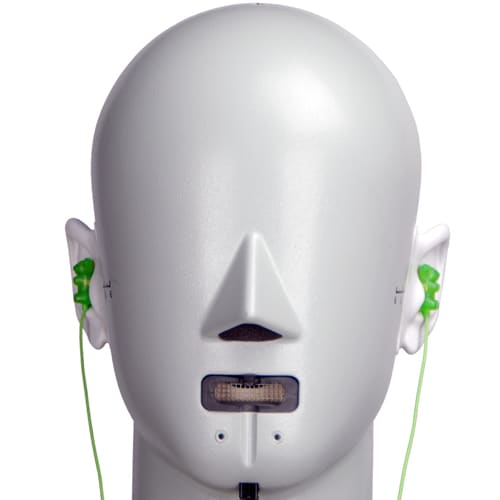
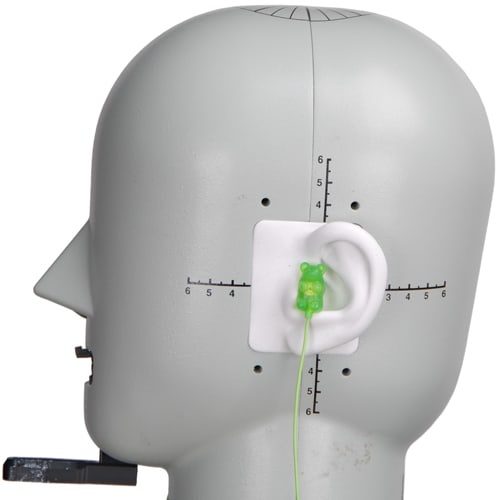
Speakers
{{section_header}}{{section.name}}{{/section_header}}
This time around, the ear buds have a more standard design to them compared to the beveled design from the previous model, the sleeves of which had a clear up and down. The tips of the nozzles have some horizontal striations, which should help them grip the sleeves and prevent the ear buds from rotating.
Sides
{{section_header}}{{section.name}}{{/section_header}}
Back
{{section_header}}{{section.name}}{{/section_header}}
Band
{{section_header}}{{section.name}}{{/section_header}}
Cable
{{section_header}}{{section.name}}{{/section_header}}
The remote and mic that the headphones' name alludes to is found a bit high up on the right ear bud's cable. It has a button and volume controls. You can single click to play/pause, double click to fast-forward, or triple-click to rewind.
The cord continues down to the 1/8-inch plug, which has the same design as its predecessor.
Additional Features
{{section_header}}{{section.name}}{{/section_header}}
In the Box
{{section_header}}{{section.name}}{{/section_header}}
In the box you'll find exactly what's pictured below: the headphones, a carrying case, and a pill-shaped case that can hold two different sizes of sleeves (in total there are 3 sizes of sleeves).
Durability
{{section_header}}{{section.name}}{{/section_header}}
As we mentioned in our last review of an Apple product, the main durability issue you'll encounter here is with the plug, specifically with its design and lack of a cord guard. Take a look at the plugs pictured below. On the left are the Apple headphones, whose cord guard looks like a long-sleeve T-shirt and provides about as much protection. The purpose of a cord guard is to stop the cord from bending too sharply. The headphones in the picture on the right are the Sony MDR-EX51s, which cost under $20.
The two headphones are being pulled an equal distance. Look at the sharp bend exhibited along the inside curve on the Apple headphones, which occurs right in the middle of the cord guard. Now, the straight plug design itself is bad, because it necessitates the headphones have a robust cord guard. The Apple headphones do not have this robust cord guard, hence the acute angle in the bend. Now, the Sony headphones have an average cord guard and a bent plug. This plug is nothing special, yet see how gradual the bend is?
We stress this issue so much because, in our experience, the plug is the first part to break. Think of all the times your headphones have started to cut out as you walked around. How many of those times did you have to jiggle the cord at the plug?
Other than the significant issues with the plug, the headphones have average durability. There's nothing especially durable about the headphones' construction or materials and there's no glaring oversights. The main reason they got the poor score they did is because of the plug issue and, to a lesser, but not minor extent, the lack of any cord guards around the control pendant.
Aesthetics
{{section_header}}{{section.name}}{{/section_header}}
It's hard to be particularly fashionable when your aesthetic is the over-done norm. No one notices in-ear headphones by brand. If they're white, people will assume they're iPod headphones. Even if you have the control pendant swaying around in the open, chances are everyone's curiosity will have been sated by the 'white = iPod' assumption. Therefore, while these aren't ugly by any stretch, they exist solely in the baseline of in-ear aesthetics. These are the headphones we judge other headphones by, for better or worse. Perhaps some company will make a hideous set that becomes more ubiquitous than the Apple headphones. If you are reading this in the future (which you obviously are since this isn't a live stream), and such headphones exist, feel free to bump the aesthetic score by a few points. Chances are, however, the opposite will happen, ala the Motorola Razr: sure, they were trendy for a while, but once they became the norm their unique form factor lost all of its appeal.
Frequency Response
{{section_header}}{{section.name}}{{/section_header}}
The Apple In-ear Headphones with Remote and Mic had ok frequency response. Their main issue that brought their score down is the downward spike just before 10kHz. This is a significant, sudden drop. It might lead to some instruments sounding slightly blanketed, especially spoken sibilance.
The 10kHz plunge aside, the headphones didn't perform poorly. They have a strong bass response, but some might find it a bit too strong. If the headphones had a slightly plateaued bass, it'd be preferable to the response curve at right, where the bass emphasis is inversely proportional to the frequency. When the bass steadily increases in volume the lower it goes, playback can sound boomy.
While the graph trends off, it does so relatively gradually (except for the valley at 10kHz). If you like bass-heavy music, the Apple In-ears might offer a good sound. If you prefer vocals, the Apple In-ears are less ideal.

Click here for more information on our frequency response test.
Distortion
{{section_header}}{{section.name}}{{/section_header}}
The Apple In-ear Headphones with Remote and Mic do not have much distortion. Annoyingly, however, there is a bit of noise present towards the high end. Chances are, your playback's volume will mask the noise and you won't notice it the majority of the time. During quiet bits, however, those with impeccable hearing will be notice the noise.
Even with the distortion, the Apple In-ears w/R&M had lower overall distortion than many headphones we've reviewed.
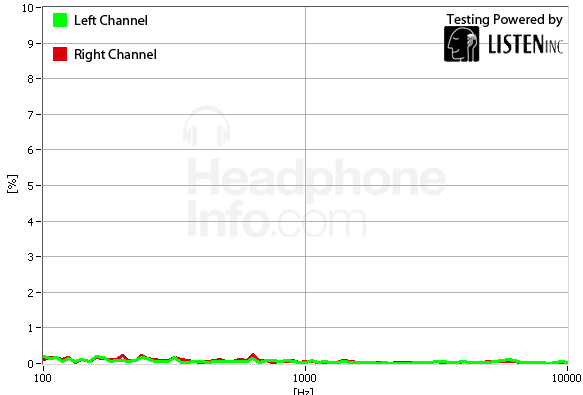
Click here for more information on our frequency response test.
Tracking
{{section_header}}{{section.name}}{{/section_header}}
The Apple In-ears had great tracking. They start off a negligible 2dB louder on the right side, which is probably due to a minor fit issue. Even towards the end, where the tracking graph usually turns into a block of scribbles, the Apple In-ears manage to remain reserved. This is one of the best tracking results we've seen to date.
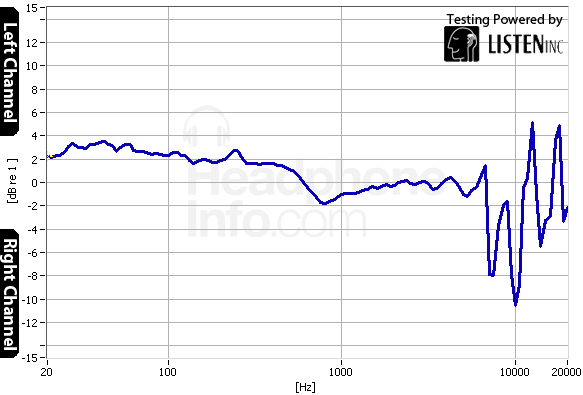
Click here for more information on our frequency response test.
Isolation
{{section_header}}{{section.name}}{{/section_header}}
The Apple In-ear Headphones with Remote and Mic had good isolation for in-ears. Good isolation for in-ears is excellent isolation for any other headphone type. Like most in-ear headphones, the majority of the sound blocked out is towards the high-end, with less blocked out from 100-1000Hz. This isn't the best isolation score we've seen for a set of in-ears, but the Apple In-ears do block out more sound on average than high-end active noise cancellers.

Click here for more information on our isolation test.
Leakage
{{section_header}}{{section.name}}{{/section_header}}
The Apple In-ears really don't have a problem with leakage. We rarely see leakage issues on in-ears that fit into the ear canal and the Apple In-ears stick with this trend. When playing back music at normal or even louder-than-normal decibel levels, someone sitting right next to you won't be able to hear anything. Of course, if you're playing music at max volume in a quiet place, nearby people will hear a bit of a whisper, so maintain reasonable volume levels in such scenarios.
Click here for more information on our leakage test.
Maximum Usable Volume
{{section_header}}{{section.name}}{{/section_header}}
The Apple In-ear Headphones with Remote and Mic were capable of a decent maximum usable volume: 119.34 decibels. We stop awarding points at the 120dB mark, because anything louder than that is doing you more harm than good. Anything withing 10dB of 120 is excellent, making the Apple In-ears excellent. You shouldn't have any volume concerns with these headphones.
Click here for more on our maximum usable volume test
Short-Term Use
{{section_header}}{{section.name}}{{/section_header}}
We thought the Apple In-ear Headphones with Remote and Mic were pretty comfortable. They had a comfortable fit that didn't exert too much pressure on the insides of our ears. Over the course of an hour we didn't really have any comfort issues with the Apple In-ears.
Unfortunately, these headphones suffer from the same issue as their predecessors they fall out of place very easily. Some of the many activities that will cause your Apple In-ears to fall out of place include:
- Moving
- Not moving
That's right, even just sitting still our ears would eventually spit these things out on their own accord. This issue is why the headphones didn't score a 7 or 8 on this section. Sure, they're comfortable, but it's annoying to have to constantly shove the things into your ears. These aren't great headphones for the gym.
Of course, as we always mention, this section is one of the part of our review that is blatantly subjective. Sure, we pass the headphones around the office and ask for opinions, but we don't have an awesome lab test for comfort, unfortunately. Always be sure to try the heapdhones on before you decide to buy or keep them. We recommend you try them on for at least as long as your listening sessions tend to last, if not longer for good measure.

Extended Use
{{section_header}}{{section.name}}{{/section_header}}
We really didn't notice any issues with comfort over the course of six continuous hours. The constant necessary readjustments represent 100% of the score difference between this score and the previous one. On the previous score, which is based on one hour of use, we naively thought, 'although it was somewhat annoying to have to push the ear buds back into place a hundred times or so, it wasn't so annoying as to make these headphones less comfortable than average.' Well, tack on another five hours of wear and about 500 more adjustments and the annoyance factor increased a bit. The issue is really a shame, given how otherwise comfortable the headphones are.
Of course, we highly recommend you try the headphones on. There's always the chance you have the golden ear shape and won't run into any issues.
Customizability
{{section_header}}{{section.name}}{{/section_header}}
Like many in-ear headphones, the Apple In-ears come with three sizes of sleeves, all of which are the standard soft plastic design. Some higher-end headphones come with a few different sleeve types or, rarely, optional in-line accessories.
While the case is nice, three sleeve sizes is the standard inclusion.
The Apple In-ears also have an adjustable neck split, but it isn't very good. One side of the adjustment slider is open, which lets the cable pop out should any undue stress be put on it. This will prevent the slider from ripping should such stress occur, but also renders the slider less effective.
The end facing away in this picture is open, letting that cable
pop out to prevent tearing.
Overall, the Apple In-ears only offer basic customizability options.
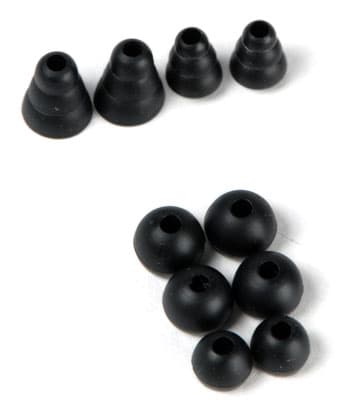
Cable Connectivity
{{section_header}}{{section.name}}{{/section_header}}
The Apple In-ear Headphones with Remote and Mic have a cord that's just under 3.5 feet long. This is long enough to stretch to a media player in the front pocket of your jeans but not much further. Most in-ear headphones are about this length, which is just about optimal for portability: any shorter and you'd have to keep your media player in a shirt pocket, or only connect to a nearby laptop, and longer and the cord would start to become a pocket-filling burden.
Portability
{{section_header}}{{section.name}}{{/section_header}}
First of all, as a set of in-ear headphones, the Apple In-ears are very portable. They use a short, thin cord, and the ear buds are tiny compared to a set of full-sized headphones. If you wanted, you could easily toss these in a pocket and forget about them. They also come with a nice case, however, which lets you wrap up the cord to avoid wrinkles. There's also a separate carrying case for sleeves that's shaped like a giant Dr. Mario pill. We would've preferred one case holding both the headphones and the sleeves, but overall the Apple in-ears are still very portable.
Maintenance
{{section_header}}{{section.name}}{{/section_header}}
Like most in-ears, there's not a lot of maintenance you can do on the Apple In-ears. There aren't any exposed screws to let you crack into them and they don't come with any cleaning tools. You can remove the sleeves should you want to clean them, which is a standard feature. The nozzles have mesh over them, but if gunk gets on it you'll need to be careful lest you push the grime through the mesh and into the guts of the ear bud.
Other Features
{{section_header}}{{section.name}}{{/section_header}}
Battery
Despite having a Remote and Mic, the Apple In-ears do not require a battery. This is marvelous, since batteries are an annoying necessity. We award points to all headphones that don't require auxiliary battery power.
Design
{{section_header}}{{section.name}}{{/section_header}}
There once was a time where black was the omnipresent coloration for in-ear headphones. Nowadays, however, white is everywhere. Regardless, we consider both headphones to be about on the same level of bland, aesthetically speaking. Apples' headphones do look a bit cleaner overall, but their design aesthetics is pretty well-worn at this point. If you disagree with us, chalk up a win for Apple. If not, this section ends in a tie.
Frequency Response
{{section_header}}{{section.name}}{{/section_header}}
These two headphones actually have similar frequency responses. The MM 50 iPs win this one though, for given the high end slightly more emphasis before their plunge.
Distortion
{{section_header}}{{section.name}}{{/section_header}}
This one is also a victory for Sennheiser, which has lower distortion overall and no noise.
Tracking
{{section_header}}{{section.name}}{{/section_header}}
Apple wins this one, with their headphones' impeccable tracking. The MM 50 iPs didn't do poorly on this test, but the Apple In-ears did exceedingly well.
Isolation
{{section_header}}{{section.name}}{{/section_header}}
The Apple In-ears actually isolate better than the MM 50 iPs on the high end, but not over the middle frequencies. Overall, the Apple In-ears blocked out more noise.
Comfort
{{section_header}}{{section.name}}{{/section_header}}
The MM 50 iPs win on the comfort test. While it's very important you try on both sets of headphones to figure out which one you think is the most comfortable, this seems to be a clear-cut victory. The Sennheisers virtually never fell out o four ears, while the Apples came loose once every minute or two.
Verdict
{{section_header}}{{section.name}}{{/section_header}}
This is actually a closer match-up than we would have thought. In terms of sher audio quality, the MM 50 iPs win. Comfort is a bit subjective, but we thought the Apples lost there as well. While the MM 50 iPs seem like the better set of headphones, the differences aren't so stark as to obviate the Apples from your decision-making process.
Design
{{section_header}}{{section.name}}{{/section_header}}
The Vibe Duos have a better design than the Apple In-ear Headphones wiht Remote and Mic. The Apples have the mainstream behind their design, while the Vibe Duos look pleasingly different.
Frequency Response
{{section_header}}{{section.name}}{{/section_header}}
The Vibe Duos have a silly amount of bass, which has a very high chance of sounding too boomy. It drops the ball with the high-end, similar to the Apple In-ears.
Distortion
{{section_header}}{{section.name}}{{/section_header}}
Even with their noisy high-end, the Apple In-ears showcased less distortion than the V-MODA Vibe Duos.
Tracking
{{section_header}}{{section.name}}{{/section_header}}
The Apples win this tracking competition handily. Look at the straight line on the left versus the squiggle on the right.
Isolation
{{section_header}}{{section.name}}{{/section_header}}
The Vibe Duo's smooth attenuation curve is relatively meaningless: on this test the only thing we care about is the area under the line, which is the amount of noise blocked out. The Vibe Duos block out a bit more high-end noise and excel at points where the Apple In-ears' graph dips down.
Comfort
{{section_header}}{{section.name}}{{/section_header}}
The Apple In-ear headphones are slightly less comfortable to wear than the Vibe Duos, primarily because the Vibe Duos don't fall out nearly as much.
Verdict
{{section_header}}{{section.name}}{{/section_header}}
The Apple In-ear Headphones with Remote and Mic might not be as pretty as the V-MODA Vibe Duos and they might pop-out about 12x as frequently, but they are better overall headphones. They are also cost about $20 less.
Design
{{section_header}}{{section.name}}{{/section_header}}
The Turbines look better than the Apple In-ears. Again, if the design wasn't beaten into the ground at this point, the Apple In-ears might've been a bit of fresh air. Unfortunately for them, the only fresh air in this scenario will be delivered by the jet-engine-like design on the turbines (we've been brainstorming ways to come up with a turbine pun now for almost three months). Both headphones also suffer from really bad plugs. The Monster Turbines gain a slight advantage here.
Frequency Response
{{section_header}}{{section.name}}{{/section_header}}
While the Turbines' issues are a bit less severe than the Apple In-ears', they showcase the same plunge in the high end. Another slight advantage for the Turbines.
Distortion
{{section_header}}{{section.name}}{{/section_header}}
The Turbines have slightly more distortion overall, but this section was close. The Turbines gently spread this distortion out over the full course of their spectrum, the Apple In-ears have their bump. Apple gains a bit of andvantage here.
Tracking
{{section_header}}{{section.name}}{{/section_header}}
Here, again, the Apples win on tracking. The Turbines didn't do half bad, however, with most of their point loss due to the erratic scribbling towards the high end. If you like even tracking, you will like the Apple In-ears.
Isolation
{{section_header}}{{section.name}}{{/section_header}}
The Turbines have a very similar attenuation curve, but don't perform as well when it comes to attenuation. They block out less noise towards the high end, but more sound overall towards the low end.
Comfort
{{section_header}}{{section.name}}{{/section_header}}
The Apple In-ears were a bit more comfortable than the Turbines, if only because they fell out slightly less. That's right, those Turbines were positively jumping out of our ears.
Verdict
{{section_header}}{{section.name}}{{/section_header}}
We think the Apple In-ear Headphones with Remote and Mic win this performance test, but again, the victory was far from a landslide. The most compelling reason to pick up the Apples in lieu of the Monsters is the price difference: the monsters cost about $150 while the Apples cost $80.
Design
{{section_header}}{{section.name}}{{/section_header}}
Since Apple fears change, this new generation of in-ear headphones looks a lot like the last in a lot of ways. Sure, the strange sleeve shape of the previous model has given way to a more traditional look, but the horrible plug has somehow survived, flying in the face of Charles Darwin. The titular remote and mic have also made an appearance, along with the uncredited volume switch. We'd say the new in-ears look better than the old ones, if only for the new in-line gadgetry.
Frequency Response
{{section_header}}{{section.name}}{{/section_header}}
These graphs are almost mirrored over a horizontal line. The new one has a strong bass response that slowly falls off towards the high end. The old one had a horrible bass response that gradually increased as it got towards the high end (before eventually falling off). We'd say the new headphones are better, because they have a slightly less erratic response.
Distortion
{{section_header}}{{section.name}}{{/section_header}}
The in-ear headphones have evolved a long way in terms of distortion. While the old headphones stockpiled distortion on the low-end, the new ones have a small cache towards the high-end. The new onew are definitely an improvement.
Tracking
{{section_header}}{{section.name}}{{/section_header}}
The new Apples have a much more even tracking than the old ones. The old headphones' performance looks like a polygraph test.
Isolation
{{section_header}}{{section.name}}{{/section_header}}
The new Apple in-ear headphones do a slightly better job at isolating.
Comfort
{{section_header}}{{section.name}}{{/section_header}}
There's no real difference in comfort between the two generations. They both fall out with the same frequency and are about as comfortable the rest of the time.
Verdict
{{section_header}}{{section.name}}{{/section_header}}
The initial Apple in-ears weren't great, but they were inexpensive. These headphones are better in many ways but cost about $50 more. We prefer the new model for its improved feature set (we hear it has a REMOTE and MIC) as well as its better isolation and sound quality. The extra money is worth it.
Conclusion
{{section_header}}{{section.name}}{{/section_header}}
The Apple In-ear Headphones with Remote and Mic might have a somewhat ridiculous name, but manage to remain a serious contender for your entry-level headphone budget. The Apple In-ears have a mediocre frequency response, some minor distortion issues, excellent tracking, and above average isolation. While they're not perfect, their overall sound quality is good for their price. Also, the control pendant offers a lot of functionality even though its buttons provide poor tactile feedback.
The main issue with these headphones is their durability. The last model had signifiant issues with its plug, all other headphones with a similar plug have similar issues, and yet this new iteration has inherited the same cursed design. If you're going to buy these, you might want to reinforce the plug yourself to protect your investment. Also, be sure to keep your receipt should they break while still in warranty.
Despite the durability issue, the Apple In-ear Headphones with Remote and Mic are a good, not great, pick for their price. If you're looking at the Apple In-ears, you might also want to check out the Sennheiser's MM 50 iPs (better audio quality), or V-MODA's Vibe Duos (new, more durable plug).
Meet the tester
Mark Brezinski works on the Home Team, reviewing refrigerators, minifridges, dishwashers, washing machines, dryers, air conditioners, air purifiers, and fans.
Checking our work.
Our team is here to help you buy the best stuff and love what you own. Our writers, editors, and experts obsess over the products we cover to make sure you're confident and satisfied. Have a different opinion about something we recommend? Email us and we'll compare notes.
Shoot us an email